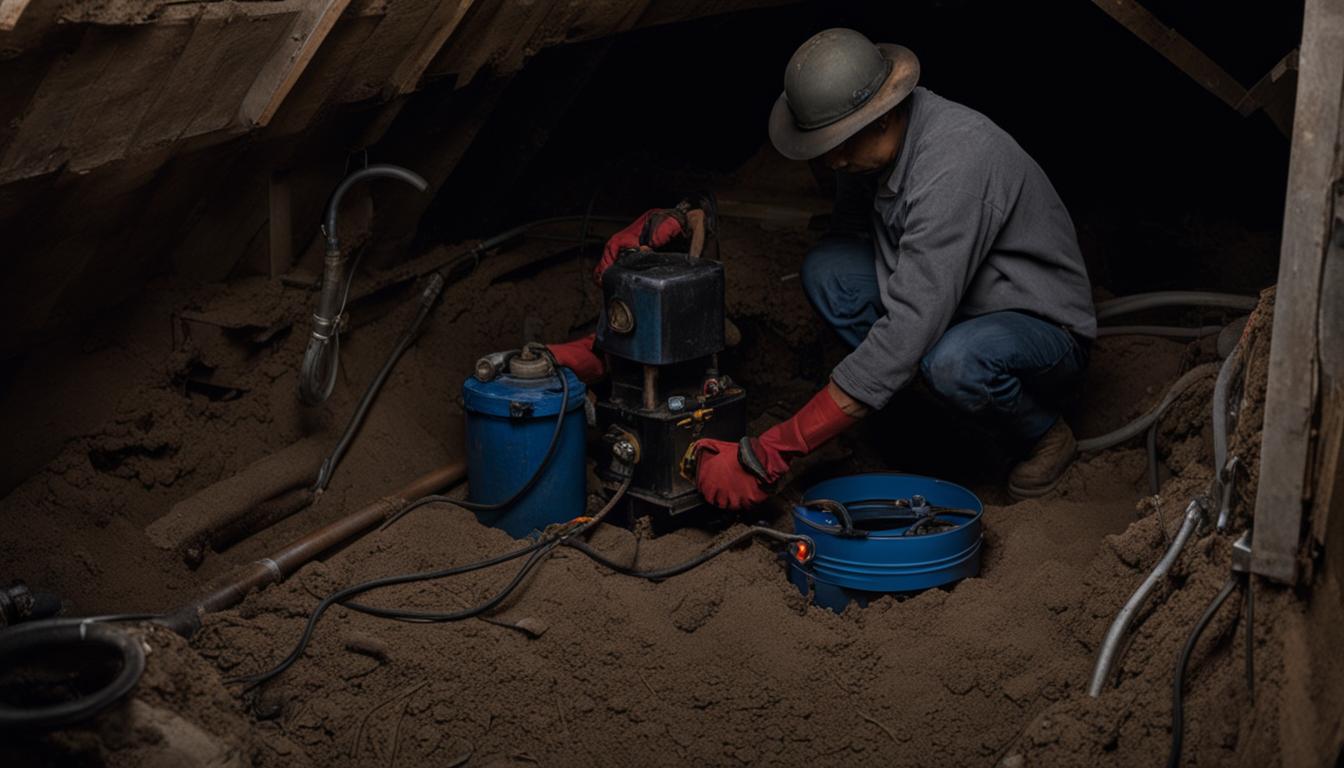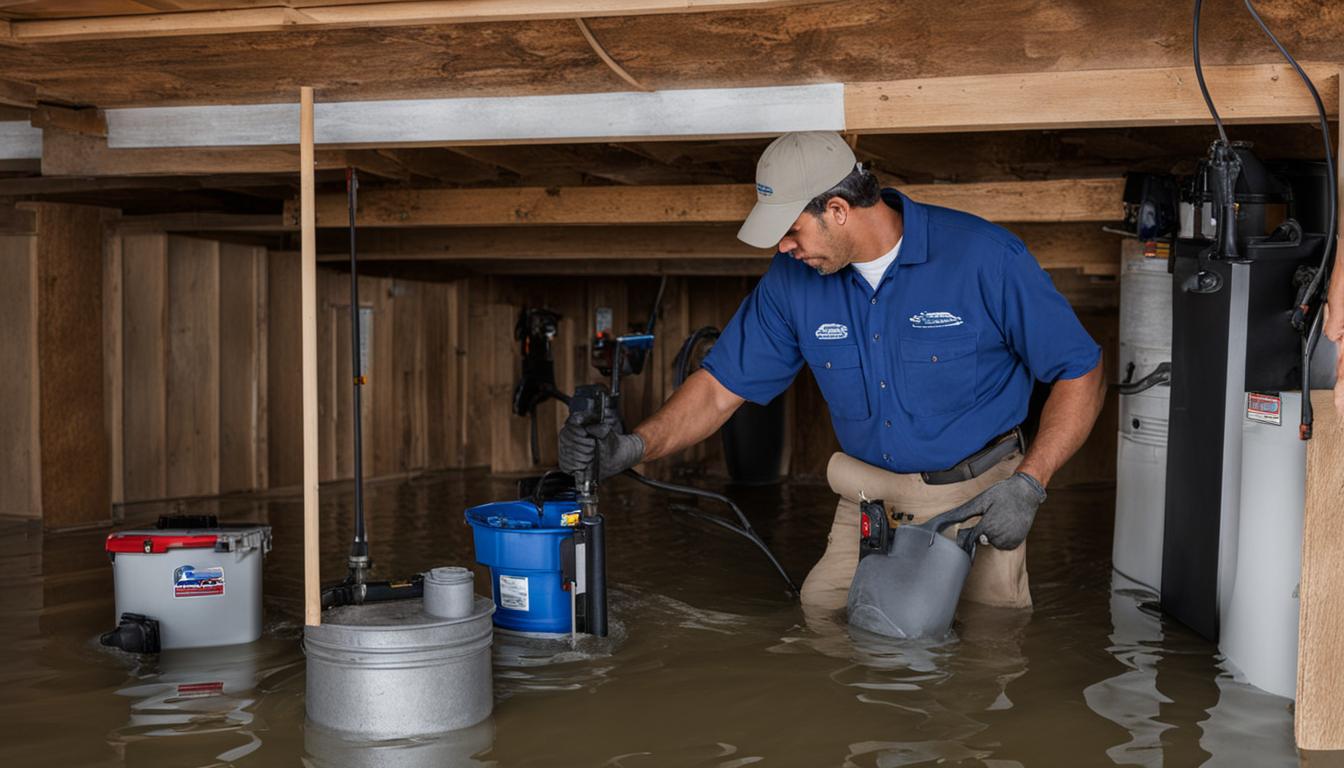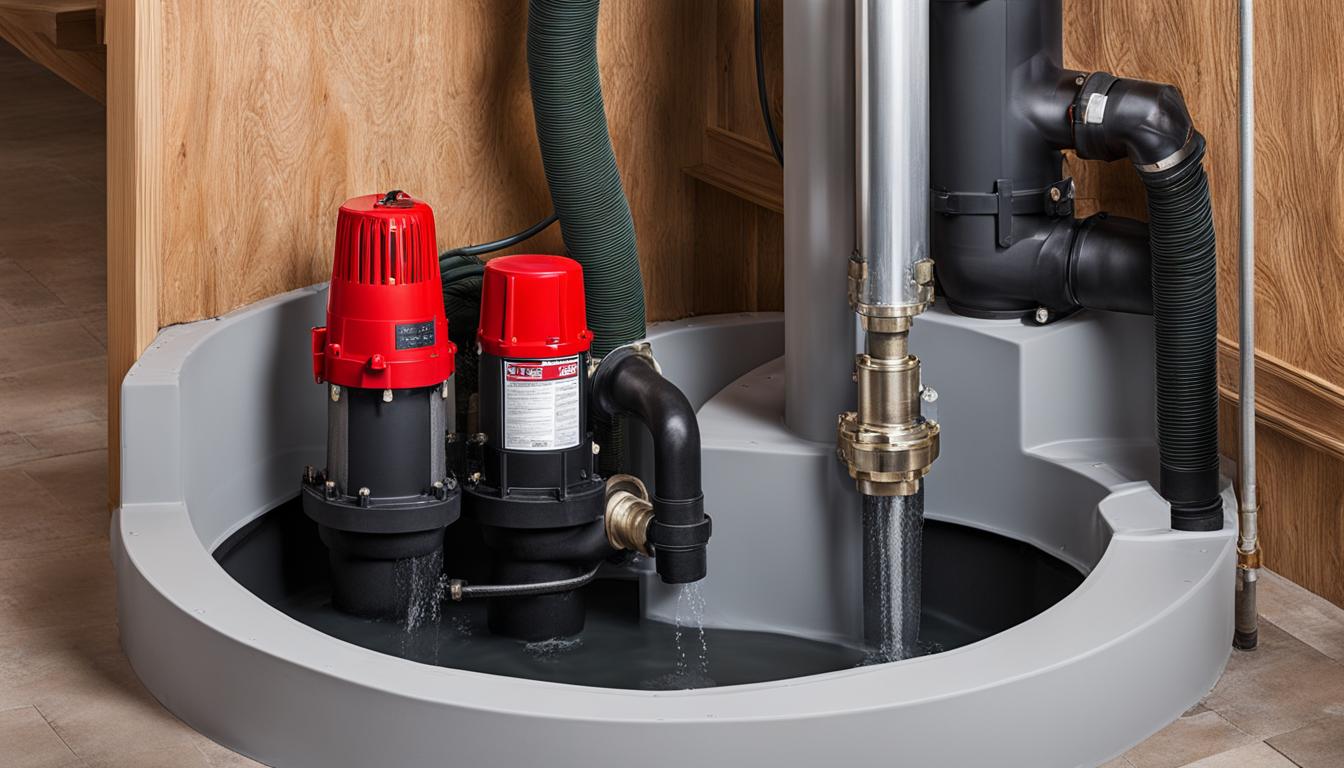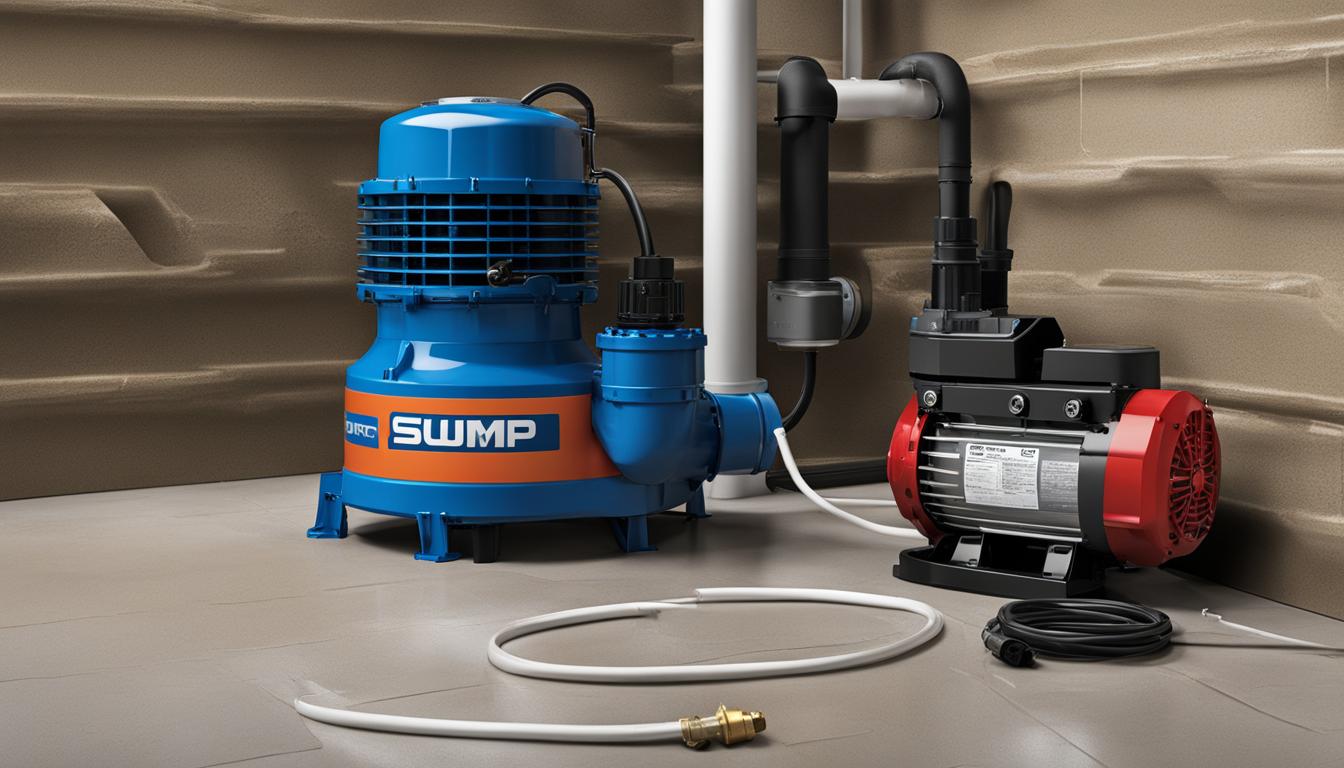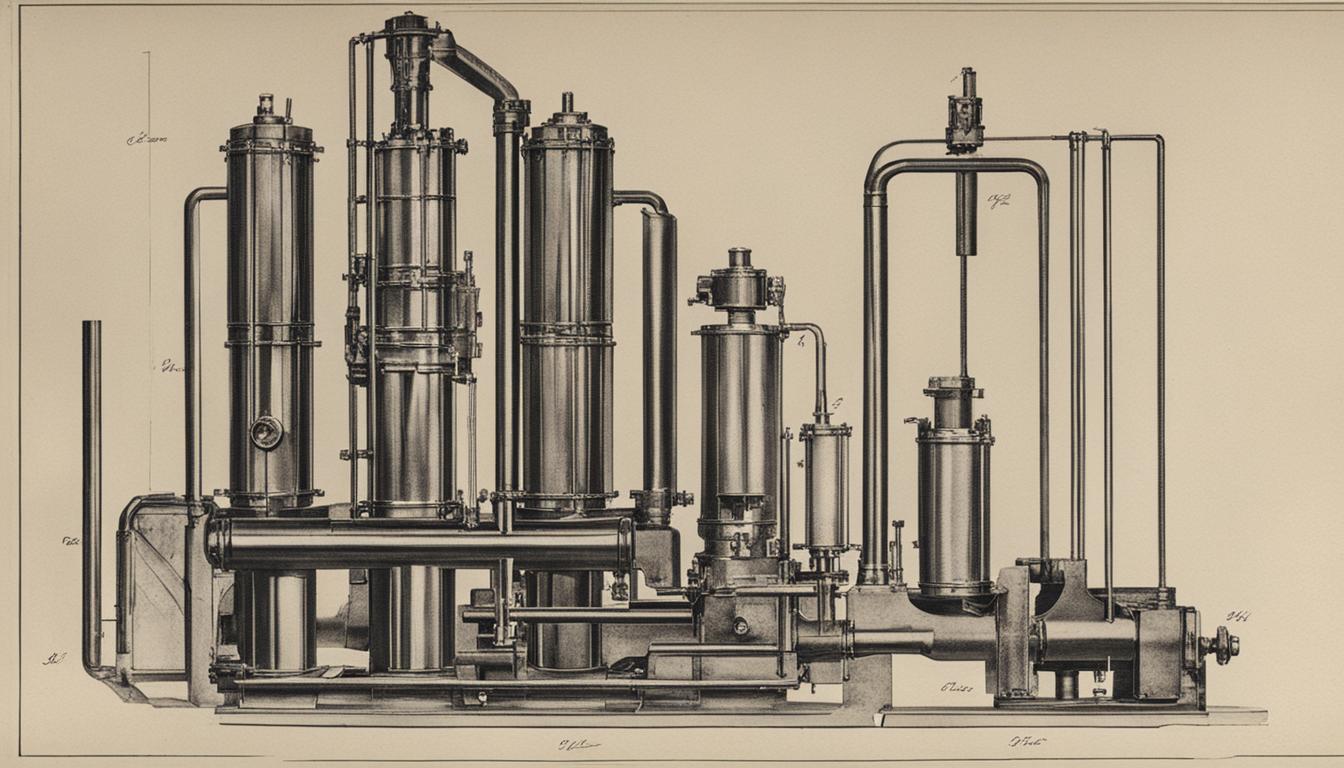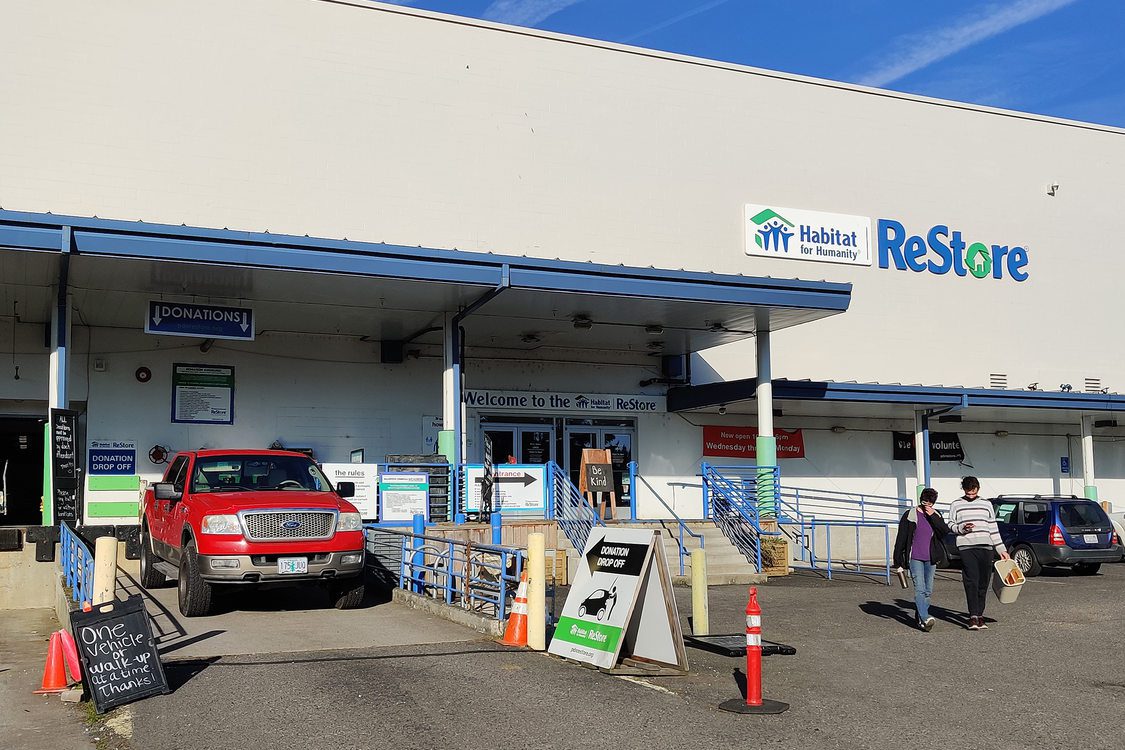Welcome to our comprehensive guide on how to install a sump pump in a crawl space. If you’re looking to manage water or moisture issues in your home’s crawl space, installing a sump pump is a smart and cost-effective solution. However, crawl space installation comes with specific challenges that require professional guidance.
In this guide, we’ll take you through the step-by-step process of installing a sump pump in a crawl space, sharing our professional tips and techniques along the way. From selecting the right sump pump to troubleshooting common issues, we’ve got you covered.
Key Takeaways:
- Installing a sump pump in a crawl space is a smart and cost-effective solution for managing water and moisture issues.
- Selecting the right sump pump is crucial before starting the installation process.
- Ensure safety precautions are taken during the installation process, including proper ventilation and personal protective equipment.
- Proper preparation of the crawl space is crucial for the successful installation of a sump pump.
- Overcoming installation challenges in a confined space requires specific techniques and creative solutions.
Selecting the Right Sump Pump for Your Crawl Space
When it comes to selecting the right sump pump for your crawl space, there are several factors to consider. The right pump will ensure efficient water management and prevent potential damage to your crawl space and property.
The following are essential factors to consider when selecting a sump pump:
Pump Type
There are two main types of sump pumps: submersible and pedestal. Submersible pumps are placed inside the sump pit, making them less visible and quieter. Pedestal pumps, on the other hand, are placed above the sump pit and have a longer lifespan due to their placement outside the pit. It is essential to choose the type that will function best in your crawl space, considering factors such as available space and noise level requirements.
Horsepower
The horsepower of the pump determines how quickly it can remove water from the crawl space. A higher horsepower pump can remove water faster but may also use more energy. The required horsepower will depend on the size of your crawl space and the amount of water it is likely to collect.
Capacity
The capacity of the pump refers to the amount of water it can remove per minute. It is essential to consider the average amount of water your crawl space collects to ensure the pump can handle it effectively.
It is also crucial to consider the quality and durability of the sump pump. Investing in a high-quality sump pump will ensure reliability and longevity, preventing potential damage to your property.
Ensuring Safety Precautions during Installation
Safety is a top priority when installing a sump pump in a crawl space. We want to ensure that everyone involved in the installation process is protected from potential hazards. Here are some essential safety precautions to follow:
- Ensure Proper Ventilation: Crawl spaces can be cramped and poorly ventilated, leading to respiratory issues. It is crucial to wear a respirator or face mask to protect against dust and other harmful particles. Additionally, opening the crawl space vents and using fans can improve airflow and reduce the risk of respiratory issues.
- Electrical Safety: Sump pumps require electrical connections, so it is important to ensure that the power supply is turned off before starting any installation work. Additionally, extension cords should never be used for sump pump connections. Instead, a grounded outlet should be used, which is up to code and safe to use.
- Personal Protective Equipment: It is essential to wear the appropriate personal protective equipment (PPE) while working in a crawl space. This includes gloves, knee pads, and protective eyewear. Safety boots with steel toes can also offer protection against potential hazards, such as falling objects.
“Proper safety measures can prevent accidents, injuries, and even fatalities during the installation process. We highly recommend taking every necessary precaution to ensure a safe installation process.”
Preparing the Crawl Space for Installation
Proper preparation of the crawl space is crucial for the successful installation of a sump pump. Our team recommends following the steps below to ensure the best possible installation:
Moisture Control Measures
Excessive moisture in the crawl space can cause various problems, including mold growth and structural damage. To prevent these issues, it’s essential to implement moisture control measures, such as:
- Installing a vapor barrier: A vapor barrier is a plastic sheet that prevents moisture from entering the crawl space. The sheet should be placed on the ground and up the walls of the space.
- Sealing vents and openings: Sealing vents and openings in the crawl space can help reduce moisture infiltration. Our team recommends using foam board, caulking, or weather stripping to seal these openings effectively.
- Installing a dehumidifier: A dehumidifier can help reduce the humidity levels in the crawl space. Our team recommends using a dehumidifier with a built-in pump, which pumps water out of the space automatically.
Managing Existing Water Issues
If you have existing water issues, such as standing water or leaks, it’s crucial to address them before installing the sump pump. Failure to address these issues can lead to decreased efficiency, increased maintenance, and potential damage to your crawl space.
“Addressing existing water issues is crucial to ensure the proper functioning and longevity of your sump pump system.”
Ensuring Proper Drainage
Proper drainage is critical to the efficient operation of your sump pump. Our team recommends installing a perimeter drain system to channel water towards the sump pump. The drain system should be sloped towards the pump, and the pipes should be at least 3 inches in diameter.
| Perimeter Drain System | Benefits |
|---|---|
| Dig a shallow trench around the perimeter of the crawl space (typically 12 inches wide and 12 inches deep). | Prevents water buildup and channels water towards the sump pump. |
| Place a perforated pipe at the bottom of the trench, sloped towards the sump pump. | Allows for proper drainage and flow towards the sump pump. |
| Cover the pipe with gravel or crushed stone. | Prevents the pipe from clogging while allowing water to flow freely. |
By following these installation preparation steps, you can ensure the best possible functioning of your sump pump system. These measures help prevent potential damage to your crawl space and provide long-term protection against water issues.
Installing the Sump Pump in the Crawl Space
Now that you have selected the right sump pump and prepared the crawl space, it’s time to start the installation process. Here are the steps we recommend:
- Position the pump: Choose the location for the sump pit, ensuring it is at the lowest point in the crawl space and away from any obstacles. Dig a hole for the sump pit, making it deep enough to accommodate the sump pump and leaving ample space for gravel to surround the pit.
- Install the sump pit: Place the sump pit in the hole and fill the bottom with a 2-inch layer of gravel. Ensure the sump pit is level and secure.
- Connect the discharge pipe: Attach the discharge pipe to the sump pump, ensuring a tight and secure fit. Run the pipe to a location outside the crawl space, ensuring it is sloped away from the house and any potential water entry points.
- Install the check valve: Attach the check valve to the end of the discharge pipe and secure it in place with a hose clamp. This will prevent backflow and ensure water flows away from the house.
- Seal the pit: Use a cover to seal the sump pit, preventing debris and odors from entering the crawl space.
- Connect the electrical: Connect the sump pump to a dedicated GFCI outlet and test the pump to ensure it is functioning properly.
It is important to note that the installation process may vary slightly depending on the type of sump pump you have selected. Always follow the manufacturer’s instructions and consult a professional if you are unsure about any aspect of the installation process.
Overcoming Installation Challenges in a Confined Space
Installing a sump pump in a crawl space can be a challenging task due to the limited access and tight working conditions. However, with the right techniques and tools, we can overcome these challenges and ensure a successful installation.
One of the first challenges to consider is the limited headroom in the crawl space. This can make it challenging to access the pit and maneuver the pump. To address this, we recommend using compact tools such as a cordless drill, adjustable wrench, and pliers. These tools can help you maneuver in tight spaces and make the installation process smoother.
Another critical challenge is the need to manage moisture and humidity in the crawl space. This can impact the effectiveness of the sump pump and the longevity of the system. To address this, it is crucial to ensure proper ventilation during the installation process. This can be achieved by installing a vent fan and opening any existing crawl space vents. Proper ventilation will also improve air quality and reduce the risk of mold and mildew growth.
Working in Teams
Working in teams can also help overcome installation challenges in a crawl space. Having a partner can help you move heavy equipment and get a different perspective on how to approach the installation process. Furthermore, working with a partner can help ensure safety precautions are taken and provide support in case an emergency situation arises.
It is also crucial to have a plan for waste management during the installation process. As you work in a confined space, waste materials can quickly accumulate, making it challenging to maneuver and work effectively. We recommend having a designated area for waste disposal and using trash bags to keep the crawl space clean and organized.
Implementing Creative Solutions
Finally, when installing a sump pump in a crawl space, you may encounter unexpected challenges that require creative solutions. For example, if you need to route the discharge pipe around an obstacle, you can use flexible PVC piping to bypass the obstruction and still maintain proper drainage. Another option is to use a battery-operated backup pump system in case of a power outage or failure of the primary pump system.
Overall, by using compact tools, working in teams, and implementing creative solutions, we can overcome the challenges of installing a sump pump in a crawl space. These techniques will help ensure a successful installation process that will effectively manage moisture and water issues in your crawl space.
Maximizing Efficiency of the Sump Pump System
At this point, your sump pump system is up and running, but how can you ensure it is operating at peak efficiency? Here are some tips:
- Regular maintenance: Performing routine maintenance tasks on your sump pump can prevent costly repairs down the line. Make sure to clean the pump and check the motor regularly, and replace the battery if you have a backup system.
- Monitor water levels: Keep an eye on the water levels in your crawl space. If the pump is running constantly, it may indicate an issue with water management or drainage.
- Implement backup systems: In case of a power outage or pump failure, it’s crucial to have a backup system in place. Consider installing a battery backup or a water-powered backup pump for added protection.
By following these tips, you can ensure that your sump pump system is operating efficiently and protecting your crawl space from potential water damage.
Regular Maintenance and Troubleshooting
Regular maintenance is the key to a long-lasting and reliable sump pump. In this section, we will discuss the maintenance tasks that should be performed periodically, and troubleshooting tips for common issues that may arise.
Regular Maintenance
Performing regular maintenance on your sump pump is essential to ensure it functions correctly. We recommend the following maintenance tasks:
| Maintenance Task | Frequency |
|---|---|
| Check the pump and float switch for proper operation | Every 3 months |
| Clean the pump and pit of any debris | Every 6 months |
| Inspect the discharge line and check valve for obstructions | Every 6 months |
| Test the backup battery (if applicable) | Every 6 months |
| Replace the backup battery (if applicable) | Every 2-3 years |
| Replace the sump pump | Every 7-10 years |
Regular maintenance will help prevent issues, keep your sump pump running smoothly, and prolong its lifespan.
Troubleshooting Tips
Despite regular maintenance, issues with your sump pump may still arise. Here are some common issues and troubleshooting tips:
- The sump pump won’t turn on: Check the power source and make sure the outlet is working. Inspect the float switch to ensure it is not stuck. Check the electrical connections for any damage or loose wires.
- The sump pump runs continuously: Adjust the float switch to ensure it is functioning correctly. Inspect the check valve to make sure it is properly installed and not damaged. Check the discharge line for any obstructions.
- The sump pump is making strange noises: The impeller may be clogged with debris. Disconnect the pump and remove any blockages. If the problem persists, the motor bearings may be worn out and need to be replaced.
- The sump pump is not draining water: Check the discharge line for any obstructions. Inspect the check valve to ensure it is not stuck closed. The pit may be too small or too shallow, causing the pump to struggle with larger volumes of water.
If you are unsure about performing any maintenance or troubleshooting tasks, contact a professional for assistance.
Conclusion
In conclusion, installing a sump pump in a crawl space is a major step in ensuring moisture control and water management within your home. Our step-by-step guide has provided professional tips and techniques to help you navigate the challenges of installing a sump pump in a confined space like a crawl space.
Proper preparation of the crawl space is key to a successful installation. We’ve discussed the importance of moisture control measures, managing existing water issues, and ensuring proper drainage. By taking these steps, you can ensure your sump pump operates efficiently and effectively.
Maintaining your sump pump is just as important as the installation process itself. Regular maintenance tasks like cleaning, testing, and replacing components ensure the longevity and reliability of your sump pump system. Our troubleshooting tips will help you identify and address any issues that may arise.
Overall, an effectively installed and properly maintained sump pump system is critical in protecting your crawl space from potential damage caused by water and moisture. By following our guide, you can rest assured that you have taken the necessary steps in securing your home’s foundation.
FAQ
How do I choose the right sump pump for my crawl space?
When selecting a sump pump for your crawl space, consider factors such as the pump type, horsepower, and capacity. It is important to choose a pump that can handle the water volume in your crawl space and meets your specific needs.
What safety precautions should I take during the installation process?
Ensuring safety is crucial when installing a sump pump in a crawl space. Some essential precautions include proper ventilation, following electrical safety guidelines, and wearing personal protective equipment such as gloves and goggles.
How should I prepare my crawl space for sump pump installation?
Before installing a sump pump, it is important to prepare the crawl space properly. This includes implementing moisture control measures, managing existing water issues, and ensuring proper drainage to maximize the effectiveness of the sump pump system.
What are the steps to install a sump pump in a crawl space?
The installation process involves positioning the pump, connecting the discharge pipe, installing a check valve, and ensuring proper electrical connections. Following a step-by-step guide and using appropriate installation techniques will help you successfully install the sump pump.
Are there any specific challenges to consider when installing a sump pump in a crawl space?
Installing a sump pump in a crawl space can be challenging due to limited access and tight working conditions. However, using compact tools, working in teams, and implementing creative solutions can help overcome these challenges.
How can I maximize the efficiency of my sump pump system?
To optimize the performance of your sump pump system, it is important to regularly maintain the pump, monitor water levels, and consider implementing backup systems for added protection. These efficiency measures will help ensure the system functions effectively.
What maintenance tasks should I perform on my sump pump?
Regular maintenance is essential for the longevity and reliability of your sump pump. Periodically, you should inspect and clean the pump, test its operation, and check for any signs of wear or damage. This will help identify and address any potential issues early on.
What should I do if my sump pump encounters problems?
If you experience issues with your sump pump, troubleshooting can help identify and resolve the problem. Common troubleshooting tips include checking power connections, clearing any blockages in the discharge pipe, and inspecting the float switch for proper functioning.
